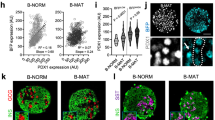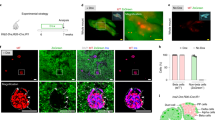Abstract
Insulin-expressing cells that have been differentiated from human pluripotent stem cells in vitro lack the glucose responsiveness characteristic of mature beta cells. Beta-cell maturation in mice was studied to find genetic markers that enable screens for factors that induce bona fide beta cells in vitro. We find that functional beta-cell maturation is marked by an increase in the glucose threshold for insulin secretion and by expression of the gene urocortin 3.
This is a preview of subscription content, access via your institution
Access options
Subscribe to this journal
Receive 12 print issues and online access
$209.00 per year
only $17.42 per issue
Buy this article
- Purchase on Springer Link
- Instant access to full article PDF
Prices may be subject to local taxes which are calculated during checkout


Similar content being viewed by others
Accession codes
Change history
07 May 2012
In the HTML version of this article initially published, an extra character in a different font of the letter ‘š’ appeared. The error has been corrected in the HTML version of the article.
References
Kroon, E. et al. Nat. Biotechnol. 26, 443–452 (2008).
Pan, F.C. & Wright, C. Dev. Dyn. 240, 530–565 (2011).
Slack, J.M. Development 121, 1569–1580 (1995).
Rozzo, A., Meneghel-Rozzo, T., Delakorda, S.L., Yang, S.B. & Rupnik, M. Ann. NY Acad. Sci. 1152, 53–62 (2009).
Rorsman, P. et al. Proc. Natl. Acad. Sci. USA 86, 4505–4509 (1989).
Richardson, C.C. et al. Diabetologia 50, 1000–1005 (2007).
Taniguchi, S., Tanigawa, K. & Miwa, I. Horm. Metab. Res. 32, 97–102 (2000).
Carvalho, C.P. et al. Diabetologia 53, 1428–1437 (2010).
Gu, C. et al. Cell Metab. 11, 298–310 (2010).
Gao, N. et al. Mol. Endocrinol. 24, 1594–1604 (2010).
Artner, I. et al. Diabetes 59, 2530–2539 (2010).
Li, C. et al. Endocrinology 144, 3216–3224 (2003).
Li, C., Chen, P., Vaughan, J., Lee, K.F. & Vale, W. Proc. Natl. Acad. Sci. USA 104, 4206–4211 (2007).
Acknowledgements
We thank W. Vale (Salk Institute) for providing anti-human Ucn3 antibody, K. Blum for writing the MATLAB BioGUI for analysis of GSIS, A. Kweudjeu for help with transcriptional arrays, C. Honore for help with FACS analyses, A. Roose, A. Cheng and F. Deng for excellent technical assistance, and D. Cohen, Y. Mayshar and F. Pagliuca for critical reading of the manuscript. We are grateful to all members of the Melton laboratory and the Harvard Medical School Critical Discussion Group for helpful discussions and experimental advice. B.B. was supported by European Molecular Biology Organization and Juvenile Diabetes Research Foundation post-doctoral fellowships. D.A.M. is an Investigator of the Howard Hughes Medical Institute.
Author information
Authors and Affiliations
Contributions
B.B. and D.A.M. conceived and designed the research. B.B., S.H., C.S., C.B. and A.R. performed the experiments. B.B. and D.A.M. analyzed the data and wrote the manuscript.
Corresponding author
Ethics declarations
Competing interests
A.Z. is an employee of BetaLogics, a division of Janssen Research & Development, LLC, one of the Johnson & Johnson Family of Companies, Raritan, NJ, USA.
Supplementary information
Supplementary Text and Figures
Supplementary Table 1, Supplementary Methods and Supplementary Figs. 1–5 (PDF 2191 kb)
Rights and permissions
About this article
Cite this article
Blum, B., Hrvatin, S., Schuetz, C. et al. Functional beta-cell maturation is marked by an increased glucose threshold and by expression of urocortin 3. Nat Biotechnol 30, 261–264 (2012). https://doi.org/10.1038/nbt.2141
Received:
Accepted:
Published:
Issue Date:
DOI: https://doi.org/10.1038/nbt.2141
This article is cited by
-
Paracrine signalling by pancreatic δ cells determines the glycaemic set point in mice
Nature Metabolism (2024)
-
Genetic lineage tracing identifies adaptive mechanisms of pancreatic islet β cells in various mouse models of diabetes with distinct age of initiation
Science China Life Sciences (2024)
-
ISL1 controls pancreatic alpha cell fate and beta cell maturation
Cell & Bioscience (2023)
-
Integrated transcriptomics contrasts fatty acid metabolism with hypoxia response in β-cell subpopulations associated with glycemic control
BMC Genomics (2023)
-
Adjudin improves beta cell maturation, hepatic glucose uptake and glucose homeostasis
Diabetologia (2023)



